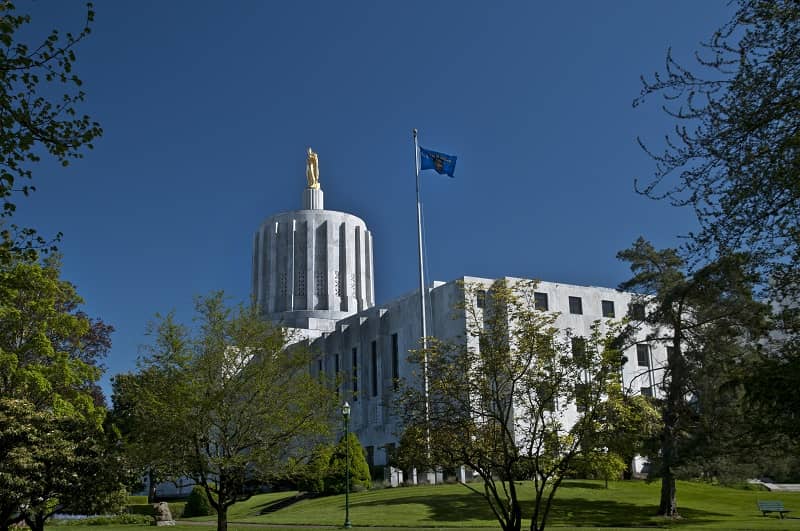By Taylor Marks
In 2014, Fire Station 21, located on SE Madison St. in Portland, was performing renovations. The project had already become bloated and surpassed several initial budgets, but all in all, the station was able to allocate just over $6 million in renovation funds, and the building was revamped. One factor that caused the city to exceed the budget is a little-known Oregon state law called the 1.5% Green Energy Technology program, or GET.
The way the program works is actually fairly simple. Since its establishment in 2007 by Oregon House Bill 2620, the GET program has required that any public building undergoing construction or renovation with a contract price of over $5,000,000 (originally $1,000,000, with the minimum price being raised in 2019) that is deemed to have potential for gathering renewable energy must also invest the equivalent of 1.5% of the contract price into “green energy technologies,” to be placed or integrated into the building to generate a portion of the building’s power. Over time, the program’s definition of “green energy technology” has expanded, going from a strict solar-only view in 2007 to now including solar, woody biomass, geothermal sources, battery storage, and other methods of energy production.
So, what is the purpose of this program? In the words of State Representative Paul Holvey (D-08), the chief sponsor of the mandate, provided during a 2007 legislative work session regarding the bill to establish the program:
The real point of this bill was really to give a boost to the solar technology industry in this state, and also to help our state move towards a renewable standard, and to help our utilities meet those standards, by government leading the way, setting the standard so to speak.
None of this comes as a particular surprise, given the nature of the program.
However, Holvey went further, and said that a key part of the bill (and the program that it established) was that it would act as a financial relief on Oregon’s taxpayers. In his own words, “But, the idea is that this mandate is really to save the taxpayer money down the road to help integrate more diverse energy sources into our grid system.” Holvey argued that by allowing public buildings to generate their own electricity, primarily via solar panels installed through the GET program, Oregon’s public buildings would not need to rely on the rest of the grid as heavily, and thus would pass on the savings to Oregon taxpayers.
In reality, the program does the opposite: The GET program forces government agencies to use public funds to build energy technologies that will never repay their construction costs. The key problem with the program is that it mandates the placement of energy-gathering technologies without giving consideration to whether or not they suit the building. In many cases, this program has forced government agencies to spend tax money on energy technology that does not make economic sense, but simply because they are required to do so.
The 1.5% requirement was intended to apply only to buildings and projects that would be deemed to be a good site for these technologies. Ostensibly, the technical review panel that oversees the program can exempt projects from the requirements if it makes sense to do so, in an effort to ensure that only efficient infrastructure is built. In practice, however, many projects are subjected to the 1.5% requirement even when any rational planner would deem them unfit, leading to the situation that the program faces today.
Because of the GET program, in addition to the $6 million in renovations, the Fire Station 21 project was required to spend at least $90,000 to build renewable energy collectors. On first impression this requirement might seem reasonable. But on closer inspection, it was a waste of taxpayer dollars.
The Portland Fire Bureau quickly realized a problem. It informed the Oregon legislature the fire station was “not the best solar site” and voiced concerns that the building wouldn’t collect very much solar power. These concerns didn’t change anything. The Fire Bureau was still required to build the solar panels by law, regardless their ability to collect any solar energy. By the end of the renovation project, the Bureau’s worries were confirmed: The solar panels would only bring in $640 of electricity annually, meaning that it would take 142 years for the panels to break even on their initial cost.
Fire Station 21 is not unique. This project, and others like it, litter the mandatory annual reports prepared by the Oregon Department of Energy on the 1.5% GET program. By forcing public buildings to invest a portion of their renovation budget into these technologies, regardless of whether the building is suited for them, the program has created absurdly low amounts of annual energy value generated through these projects.
| Year: | 2014 Projects | 2015 Projects | 2016 Projects | 2017 Projects | 2018 Projects | 2019 Projects | 2020 Projects | 2021 Projects |
| Most Expensive GET Project: | $1,222,554; Oregon State Hospital | $463,000; Applied Technology Bldg. (Salem) | $1,217,001; Multnomah County Health Department | $6,605,000; Multnomah County Central Courthouse | $1,590,135; Lane Community College | $5,900,000; Oregon Military Department | $1,204,082; Gardiner Middle School | $2,144,192; McDaniel High School |
| Least Expensive GET Project: | $41,500; ODOT Project Delivery Building | $1,200; Port of Siuslaw Fish Cleaning Station | $35,185; Grover Cottage Renovation | $28,160; ODOT Lawnfield Storage Building | $25,180; MYCF Grover Renovation | $49,762; Howard Street Charter School | $74,500; Jackson County Scenic Fire Station | $86,390; Sheldon Pool Expansion |
| Average Cost per GET Project: | $333,395 | $131,697 | $388,452 | $979,342 | $413,985 | $740,013 | $484,170 | $485,810 |
| Longest Payback Period (Annual Value Meeting Total Expenditure): | 142 years; Portland Fire Station 21 | 97 years; Patriot Hall Redevelopment Project | 41 years; RVYCF New Bridge High School | 492 years; Multnomah County Central Courthouse | 223 years; Lane Community College | 63 years; Oregon Military Department | 149 years; Salem Police Station | 127 years; Howard Elementary School |
| Shortest Payback Period (Annual Value Meeting Total Expenditure): | 5 years; Henley Elementary School | 27 years; Madras High School | 14 years; Grover Cottage Restoration | 19 years; Central Oregon Community College | 10 years; MYCF Grover Renovation | 16 years; Rogue Community College | 17 years; Douglas High School | 23 years; Kellogg Middle School |
| Average Payback Period (Annual Value Meeting Total Expenditure): | 64 years | 49 years | 30 years | 81 years | 52 years | 37 years | 51 years | 69 years |
In the 2007 work session before the program’s establishment, Jeremiah Baumann, a representative for the Oregon State Public Interest Research Group, tried to assuage concerns over long payback periods. In his words:
The payback, however, is a pretty long period of time right now, public institutions are owning those buildings for a very long period of time, and they’re in the best position to take on a long payback period. It doesn’t matter if it’s a 10, 15, 20, 25 year payback, government agencies tend to be building buildings that are going to be lasting for that long and own them for that long.
Baumann’s argument was that while the payback periods might seem long, given the nature of government buildings, the energy equipment would still be in use long enough to repay its construction costs. Baumann described a 25-year payback period as an example of a long, but justified, expense. After the program’s enactment, Baumann’s predictions were blown out of the water.
Throughout the entire recorded history of the 1.5% GET program, the average payback period for a project meeting the GET requirements has never been lower than 30 years. In the most recent report detailing projects that were funded in 2021, the average time for a payback period was 69 years.
In 2018, Lane Community College’s mandated solar and geothermal energy renovations were estimated to break even 223 years after construction. In 2020, the Salem Police Station was forced to install solar technology that wouldn’t repay its construction cost until 149 years later. In 2017, the new Multnomah County Courthouse broke the chronological bank by being required to construct energy technology, in the form of a large solar panel array, that would only manage to recoup its construction costs 492 years later. Most of these technologies require replacement or maintenance within 40 years, adding additional costs, and extending the payback period even further.
Almost none of the projects will recover the costs of their investments. In many cases, the 1.5% GET program spending appears to be a waste of money. But, it could also be argued that wasting money is one of the purposes of the law. It’s a version of the age-old “bootleggers and Baptists” phenomenon. On the one hand, environmentalists advocate for the program as a small way to get to their “net zero” carbon goals. On the other hand, contractors and trade unions see the program as a way to increase the budgets to benefit themselves and their members. Electrician unions pushed for the initial bill, forestry interests expanded it to include wood-based renewables, and clean energy companies have lobbied for the subsequent versions of the program.
The GET program has failed the predictions and expectations made prior to its creation. Rep. Holvey’s vision of a money-saving green energy-producing mandate has been shown to result in public buildings being forced to adopt expensive technologies that do not generate enough electricity to justify their installation, causing a loss of public funds instead of savings. Jeremiah Baumann’s predictions of the payback periods being short enough for public buildings to recoup the installation costs of the energy technologies has also been shown to be false, with Baumann’s longest predictions of 25 years being far exceeded by the centuries-long realities of the program’s payback periods. The GET program simply has not resulted in its expected outcomes, and it has become a hole for public funds to be shuffled into, with little to nothing in return.
Ideally, the 1.5% GET program should be shut down, in favor of a more targeted style of energy policy. The broad-strokes universal mandate method has been shown to be costly and ineffective. Like the Business Energy Tax Credit program before it, now that the GET program has proven itself to be dysfunctional, it is time for the legislature to allow it to fade away. However, if this form of energy policy is to be maintained, it is essential that it be rigorously reformed.
There is a smarter way to run this program. In fact, there are two ways.
Method one for reforming the GET program is straightforward: Officials should be a lot stricter about which projects actually fall under this requirement. As it stands now, despite having a mandate to enforce the 1.5% requirement on public projects only where it actually makes sense, the GET program widely approves enforcement of the program on nearly every project that comes through its doors. If ODOE administrators and regulators wanted to reduce the amount of public money lost, they should simply take their mandate more seriously. If the technical review panel, for instance, required every public building to pencil out the potential annual value versus the cost for each potential GET project, and then only enforced the 1.5% requirement on projects that had a payback period of 20 years or less, or at the very least on projects whose payback period wouldn’t be longer than the lifespan of the energy technologies installed onto the buildings, ODOE could easily avoid horror stories like Fire Station 21 or the Multnomah County Courthouse.
The second method would be to place the decision in the hands of the departments overseeing each individual construction project. In the case of Fire Station 21, if the Fire Bureau had final say over whether or not to install solar, it likely would have chosen not to, as the bureau had raised the original concern that the site was a poor choice for solar power. Had this happened, the public expenditure would not have happened, and what amounts to the loss of public funds would have been avoided. By doing away with the universal mandate, and allowing individual project managers to make the final call on whether or not their project makes sense to construct green energy technologies, Oregon could avoid altogether the lengthy payback periods for public money.
The GET program bleeds public funds in too many cases. Either ODOE regulators must be stricter with which projects the requirement applies to, or the final decision should be given back to the project administrators themselves. Without either of these reforms, the program will continue to force public buildings to generate energy in extremely inefficient ways, and it will continue to misuse public funds on projects that simply don’t work.
Taylor Marks is a Research Associate at Cascade Policy Institute, Oregon’s free market public policy research organization.













Bill Udy
The GET program should be shut down for another reason. It’s not the purpose of government to be mandating ways to save energy, or to “boost the solar technology industry”, or to “help our state move towards a renewable standard”, or “help utilities meet those standards”. The purpose of government should be to protect our freedom to “purse happiness” in any way we wish. The federal and state government should not even have an opinion on what form of energy people use. People will figure that out on their own.
If Senator Holvey and other government lovers wanted to save taxpayers money, the best way to do that would be to reduce or eliminate taxes.
Bob Elvis Clark
Good Reporting.